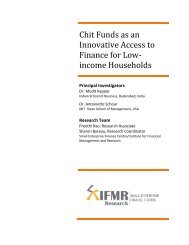Government of India Volume I: Analysis and Recommendations
Government of India Volume I: Analysis and Recommendations
Government of India Volume I: Analysis and Recommendations
You also want an ePaper? Increase the reach of your titles
YUMPU automatically turns print PDFs into web optimized ePapers that Google loves.
CHAPTER 4<br />
Functions <strong>and</strong> powers <strong>of</strong> the<br />
regulator<br />
The regulator acts like a mini-state in that it exercises legislative powers in the form <strong>of</strong><br />
drafting regulations that are binding on regulated entities; it acts as the executive in its<br />
supervision <strong>and</strong> enforcement actions; <strong>and</strong> it performs a quasi-judicial function while assessing<br />
compliance with the law by regulated entities <strong>and</strong> compliance <strong>of</strong> processes by<br />
the regulator while imposing penalties on them.<br />
While giving these wide ranging powers to the regulators, the draft Code on regulatory<br />
governance needs to put in place appropriate checks <strong>and</strong> balances to ensure that<br />
the powers are not misused <strong>and</strong> proper regulatory governance processes are followed in<br />
every action taken by the regulator.<br />
The Commission has identified the following areas for which regulatory governance<br />
processes need to be clearly detailed in the draft Code:<br />
1. Process for issuing regulations <strong>and</strong> guidelines;<br />
2. Executive functions - granting permission to carry on financial activities, information gathering,<br />
investigation, imposition <strong>of</strong> penalties <strong>and</strong> compounding <strong>of</strong> <strong>of</strong>fences; <strong>and</strong><br />
3. Administrative law functions.<br />
4.1. Issuing regulations <strong>and</strong> guidelines<br />
The primary function <strong>of</strong> a financial sector regulator is to set down st<strong>and</strong>ards <strong>of</strong> behaviour<br />
expected from regulated entities. This encompasses making regulations governing how<br />
the regulated entities should interact with the regulator, consumers, financial markets<br />
<strong>and</strong> other regulated entities. Regulations also guide the internal functions <strong>and</strong> actions <strong>of</strong><br />
regulated entities in the conduct <strong>of</strong> financial activities.<br />
In a system governed by the rule <strong>of</strong> law, no action should be judged against unknown<br />
st<strong>and</strong>ards. Therefore, before the regulator can carry out any supervision or adjudication<br />
functions it has the responsibility to lay down in clear <strong>and</strong> unambiguous terms, the behaviour<br />
that it expects from regulated entities. While doing so, the regulator needs to<br />
follow a structured process that allows all stake-holders to be fully informed <strong>of</strong> <strong>and</strong> participate<br />
in the regulation-making process.<br />
Some existing regulators have already adopted the good practice <strong>of</strong> carrying out<br />
public consultations in the course <strong>of</strong> making regulations. However, the Commission<br />
FINANCIAL SECTOR LEGISLATIVE REFORMS COMMISSION 29



